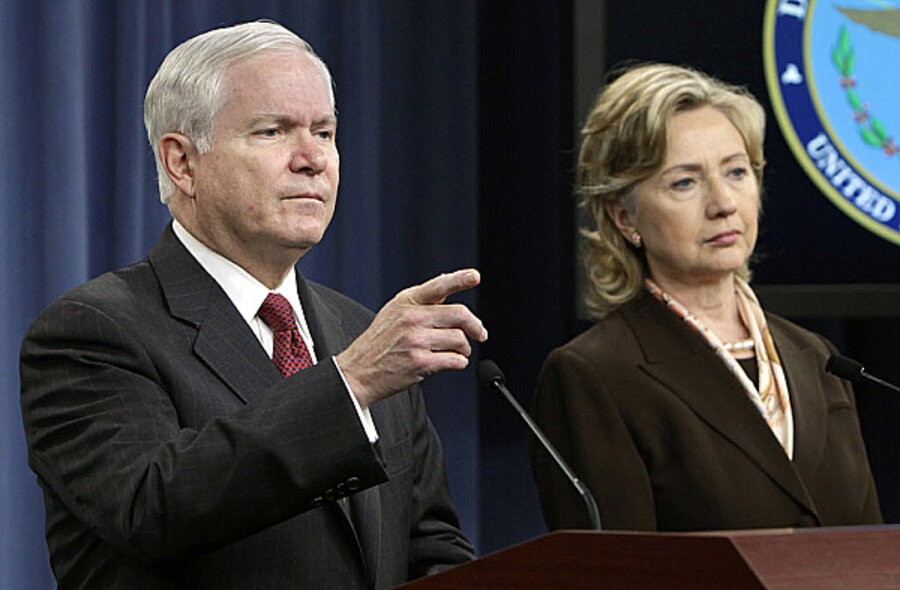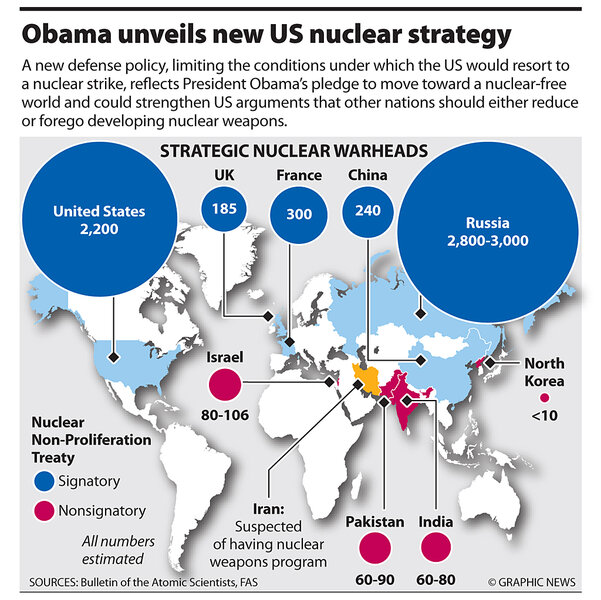Obama puts new limits on US use of nuclear weapons
Loading...
| Washington
The Obama administration began its journey toward a world free of nuclear weapons by declaring that it would rely on such weapons less and conventional weapons more.
But in making what amounted to minor changes to its nuclear deterrence policy, it settled on the political middle ground, angering the left for what the administration didn’t do, and the right for what it did.
The Pentagon Tuesday released the Nuclear Posture Review (NPR), a nearly 70-page, unclassified position paper that narrows the number of targets against which the US could use a nuclear weapon while maintaining the long-held right to launch first.
The NPR dictates that the US will not use a nuclear weapon against a non-nuclear state. This is a change from when the US maintained the right to use a nuclear weapon against any state attacking it with a weapon of mass destruction – including chemical or biological weapons – a restrictive move that helps put the US on the road to a nuclear weapon-free world.
But that pledge also includes a major caveat that gives the new policy plenty of wiggle room: the US still reserves the right to use a nuclear weapon against any country if it is not in compliance with “nonproliferation obligations” under international agreement, which means an attack against a country such as Iran.
“If a non-nuclear weapon state is in compliance with the nonproliferation treaty and its obligations, the US pledges not to use or threaten to use nuclear weapons against it,” Defense Secretary Robert Gates said at the Pentagon Tuesday. “If any state eligible for this assurance were to use chemical or biological weapons against the United States or its allies or partners, it would face the prospect of a devastating conventional military response.”
'First-use' policy remains
The new document maintains the status quo when it comes to “first-use,” giving the Obama administration the right to attack first if it decides it is in the interest of national security, a move that heartens conservatives opposed to negotiated arms control.
President Obama, who was said to have been deeply involved in the effort, likely wanted to make deeper cuts to the nuclear weapon posture, but political pragmatism weighed against ideological determination.
“I think in his heart of hearts, he would have liked to go further, but you take what you can get,” says Christopher Hellman with the National Priorities Project, in Northampton, Mass. “I think we could have done better, but I’m not surprised we didn’t. We certainly could have done worse.”
The document’s release comes two days before Mr. Obama and Russian President Medvedev are to sign a historic agreement limiting the number of weapons in each country’s nuclear arsenal.
Although some critics on the left say the new policy document doesn't go far enough, critics on the right say what is significant about the new direction is how it signals to friend and foe alike that the US is softening its ability to deter an attack.
“The US not having a strong, reliable nuclear deterrent is basically an invitation for other people to get into the game and compete,” says James Carafano, a senior analyst at the Heritage Foundation, a conservative think tank in Washington.
Additionally, says Mr. Carafano, the success of the new nuclear posture ultimately will be decided by Congress, which decides which programs to fund. He thinks Congress will go along with most of what Obama has suggested.
“In the end, what we’re going to have is a smaller, less reliable nuclear deterrent,” Carafano says.
Defense Secretary Gates has pushed the Pentagon bureaucracy to move toward a defense posture that better reflects the world today.
Russia and China still major threats?
Despite nearly a decade of fighting terrorists around the globe, many still fear that the real threat posed to the United States remains with large potential enemies such as Russia or perhaps China. To the extent that the new nuclear posture reflects a ratcheting down of the nuclear threat, the US can concentrate more on other, perhaps more realistic threats.
“The reality of the world that we live in today and the world that we anticipate living in, we have to expand the spectrum that we watch and guard against in this area,” said Gen. James Cartwright, vice chairman of the Joint Chiefs of Staff, at the Pentagon Tuesday, including nuclear weapons, terrorism, and inter-continental weapons. “Our defensive capabilities, our deterrent capabilities, must be able to address that entire span.”
The document also marks a shift in that it puts the threat of nuclear terrorism above that from a conventional enemy.
The “New START” treaty Obama and Medvedev will sign this week may represent a new era in US-Russia relations. Indeed, the Nuclear Posture Review declares that “Russia and the United States are no longer adversaries and prospects for military confrontation have declined dramatically.”
But the document isn’t as sanguine about China, which has remained relatively opaque as it modernizes its military – including a limited nuclear capability. States the NPR: “The lack of transparency surrounding its nuclear programs, their pace and scope, as well as the strategy and doctrine that guides them, raises questions about China’s future strategic intentions.”






